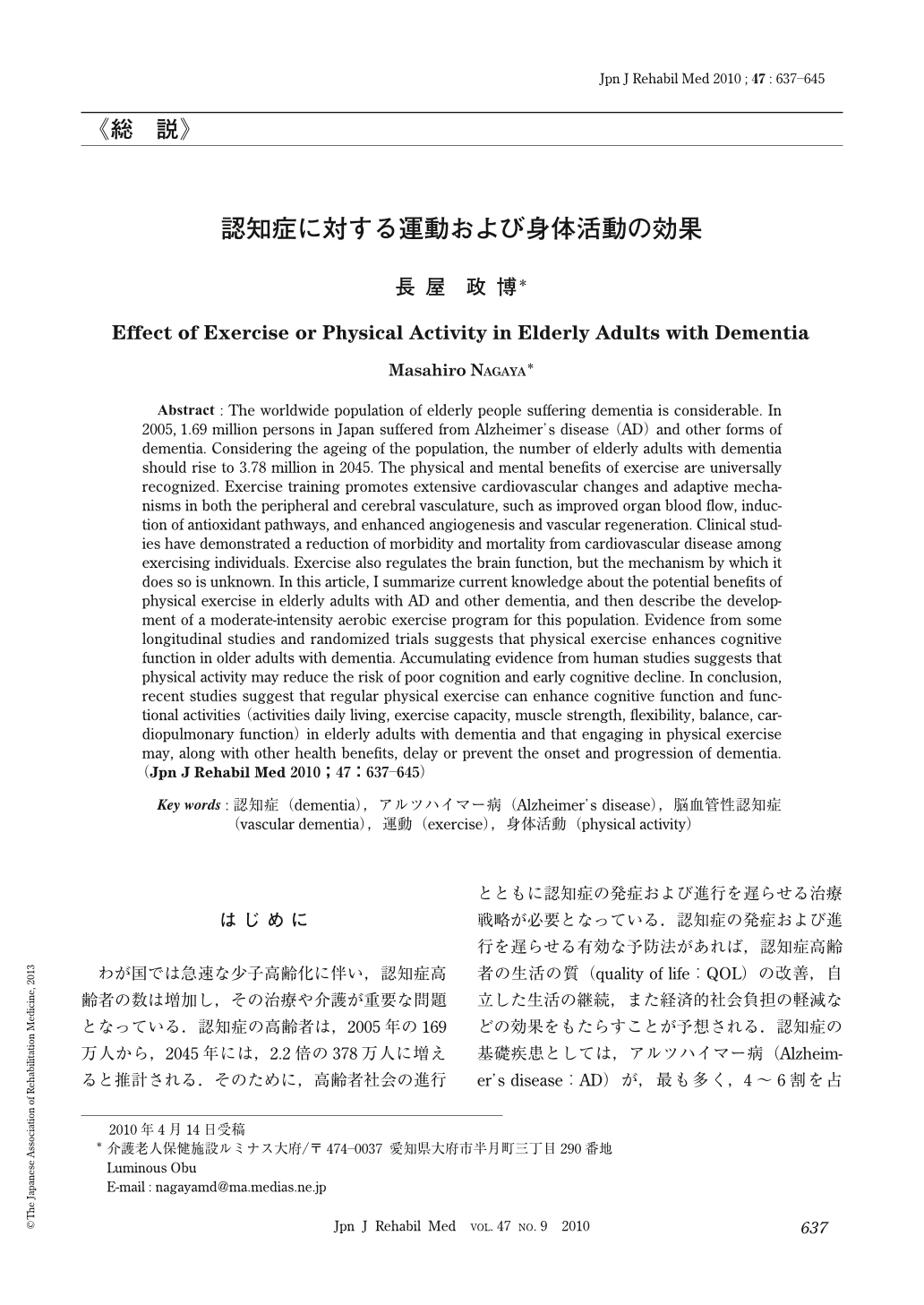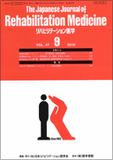Japanese
English
- 販売していません
- Abstract 文献概要
- 1ページ目 Look Inside
- 参考文献 Reference
はじめに
わが国では急速な少子高齢化に伴い,認知症高齢者の数は増加し,その治療や介護が重要な問題となっている.認知症の高齢者は,2005年の169万人から,2045年には,2.2倍の378万人に増えると推計される.そのために,高齢者社会の進行とともに認知症の発症および進行を遅らせる治療戦略が必要となっている.認知症の発症および進行を遅らせる有効な予防法があれば,認知症高齢者の生活の質(quality of life:QOL)の改善,自立した生活の継続,また経済的社会負担の軽減などの効果をもたらすことが予想される.認知症の基礎疾患としては,アルツハイマー病(Alzheimer's disease:AD)が,最も多く,4~6割を占めている.加齢とともに有病率は増加し,65歳以上の人口の2~4%程度,80歳以上の人口の20%前後がADを有するとされている1).その次に脳血管性認知症,レビー小体型認知症が基礎疾患では多いとされている.これらの認知症に対して,薬物療法ならびに非薬物療法を併用することが実際の臨床では行われているが,認知症の進行を予防するか維持することが現状である.認知症に対する非薬物的療法としては,回想法,リアリティオリエンテーション,行動療法,sensory stimulation,音楽療法,理学療法(筋力強化,バランス訓練,関節可動域訓練),作業療法(家事・家庭内役割作業,手工芸・工作),レクリエーション,園芸療法,演芸療法,社会心理療法,散歩,各種体操療法(ラジオ体操,リズム体操,民謡体操,ストレッチ体操,肩こり体操),ダンスなどがあり,環境の整備,介護者への教育・指導など多岐にわたる.この中でも運動は,認知症の非薬物療法として,重要な位置を占めている.認知症高齢者では認知症が進行してくると,身体機能の低下も目立ってきて,歩行障害,転倒リスクの増大,四肢の固縮,四肢関節拘縮,日常生活動作の低下などをきたしやすい.また認知症に伴ううつ状態など意欲の低下で身体活動が制限されたり,転倒に伴い移動能力の低下をきたすことによって,日常生活動作のより一層の低下を引き起こし,さらにこれが身体活動を低下させるという悪循環に陥ることがある.身体活動や運動は,認知症高齢者にとって,健康の維持に必要なものであり,その上で,身体活動の低下に伴う日常生活動作の低下という廃用症候群を予防する効果を期待できるし,最近では,運動による認知機能の低下を予防する可能性も期待されている.
一般的に運動は,高齢者で身体機能に確実な効果があることが報告されている.報告されている運動には,歩行,ジョギング,ハイキング,自転車,有酸素運動,筋力強化トレーニング,ストレッチング,柔軟性向上訓練,バランス訓練,関節可動域訓練,レクリエーション,体操,ダンス,身体活動を伴うゲームなども含まれる.これらの運動が高齢者の身体機能の低下や廃用症候群を引き起こすリスクを低下させるといわれている2).具体的には,心拍数を減少し,血圧を低下させ,死亡率を減少させ,脳卒中,心疾患などの心血管系疾患のリスク3,4)を改善し,転倒5)を減少させ,身体機能を向上させることが知られている.また運動および身体活動は,身体機能の改善をもたらすだけでなく,心理的効果も生み出すことが知られている.横断的研究では,身体的に活発なライフスタイルが認知機能のいくつかの評価で良い効果が報告されている6~8).また不安やうつなどの心理機能にも良い効果を生み出すことが報告されている.
本稿では,認知症高齢者で運動が認知症の進行を予防するか,また運動が認知症の発症予防に対する効果について最近の報告からまとめた.
Abstract : The worldwide population of elderly people suffering dementia is considerable. In 2005, 1.69 million persons in Japan suffered from Alzheimer's disease (AD) and other forms of dementia. Considering the ageing of the population, the number of elderly adults with dementia should rise to 3.78 million in 2045. The physical and mental benefits of exercise are universally recognized. Exercise training promotes extensive cardiovascular changes and adaptive mechanisms in both the peripheral and cerebral vasculature, such as improved organ blood flow, induction of antioxidant pathways, and enhanced angiogenesis and vascular regeneration. Clinical studies have demonstrated a reduction of morbidity and mortality from cardiovascular disease among exercising individuals. Exercise also regulates the brain function, but the mechanism by which it does so is unknown. In this article, I summarize current knowledge about the potential benefits of physical exercise in elderly adults with AD and other dementia, and then describe the development of a moderate-intensity aerobic exercise program for this population. Evidence from some longitudinal studies and randomized trials suggests that physical exercise enhances cognitive function in older adults with dementia. Accumulating evidence from human studies suggests that physical activity may reduce the risk of poor cognition and early cognitive decline. In conclusion, recent studies suggest that regular physical exercise can enhance cognitive function and functional activities (activities daily living, exercise capacity, muscle strength, flexibility, balance, cardiopulmonary function) in elderly adults with dementia and that engaging in physical exercise may, along with other health benefits, delay or prevent the onset and progression of dementia.

Copyright © 2010, The Japanese Association of Rehabilitation Medicine. All rights reserved.


